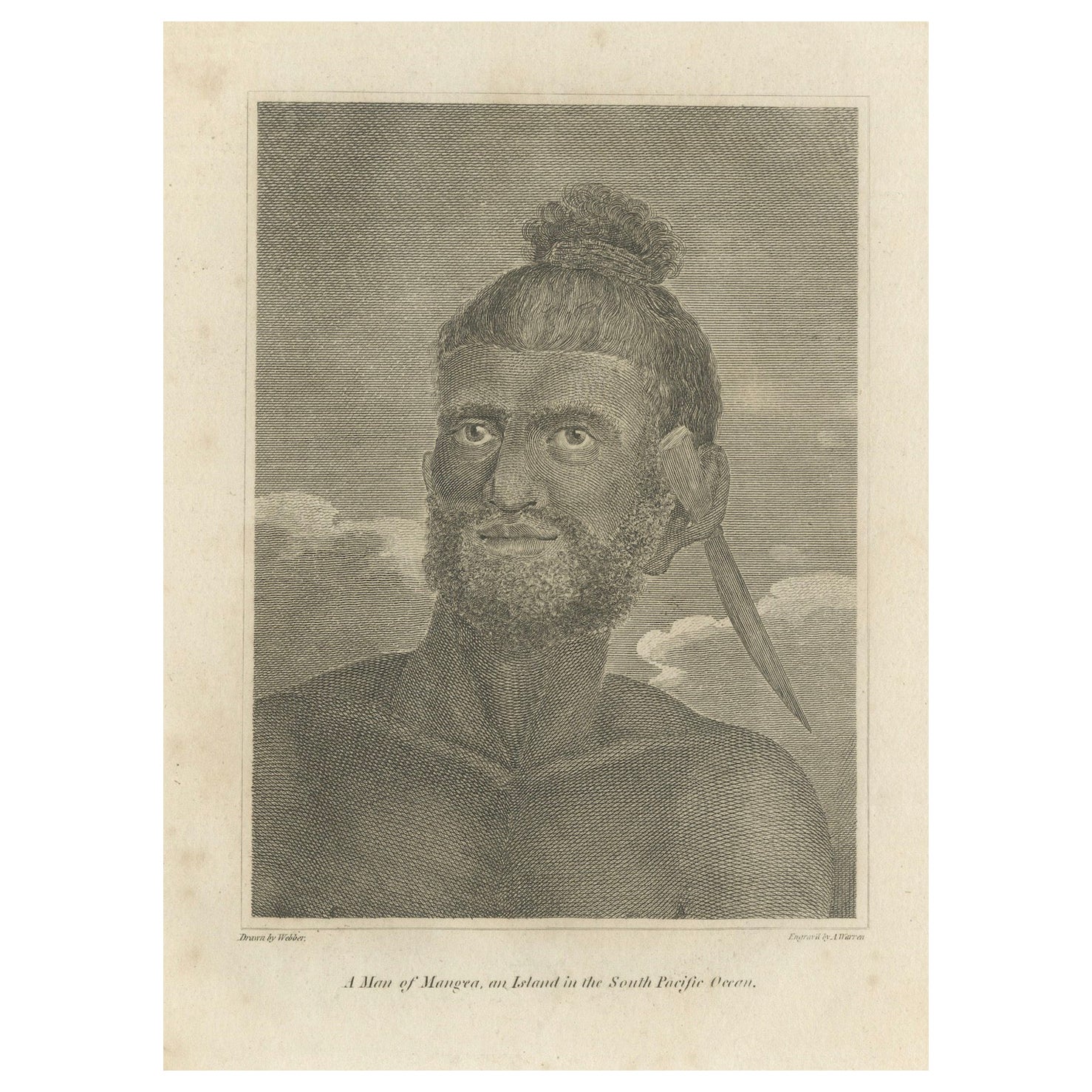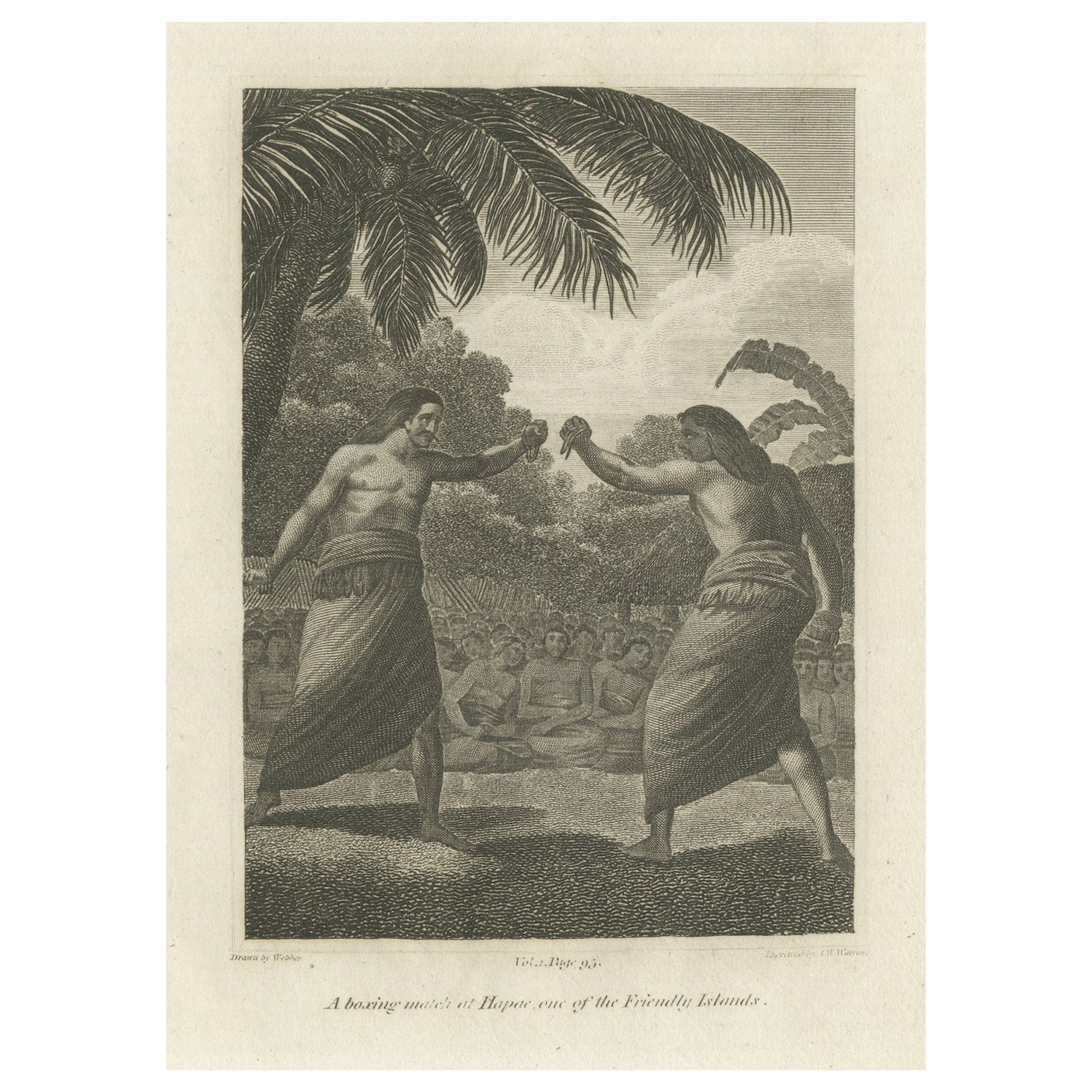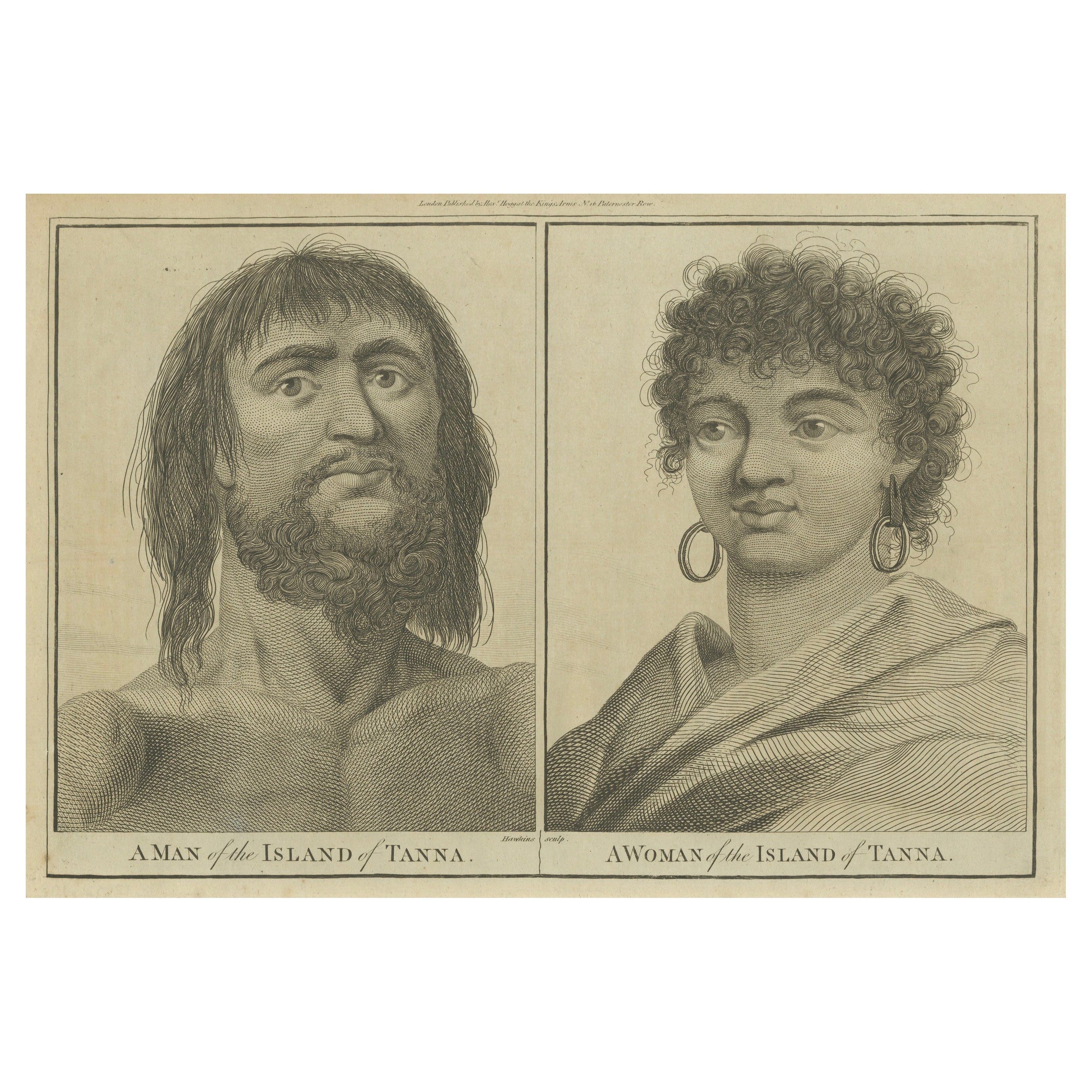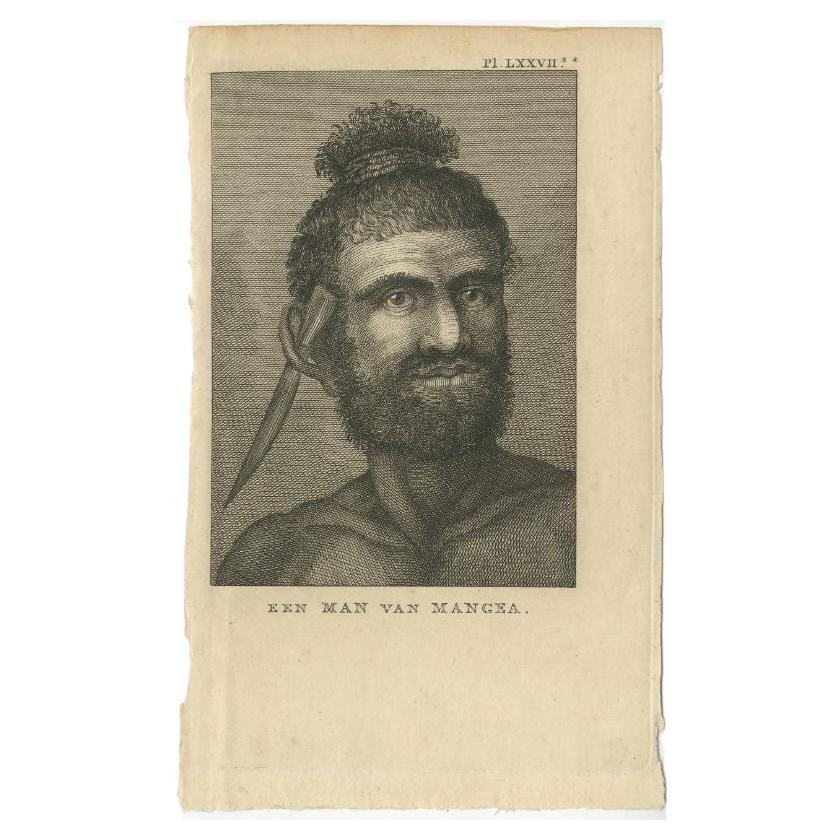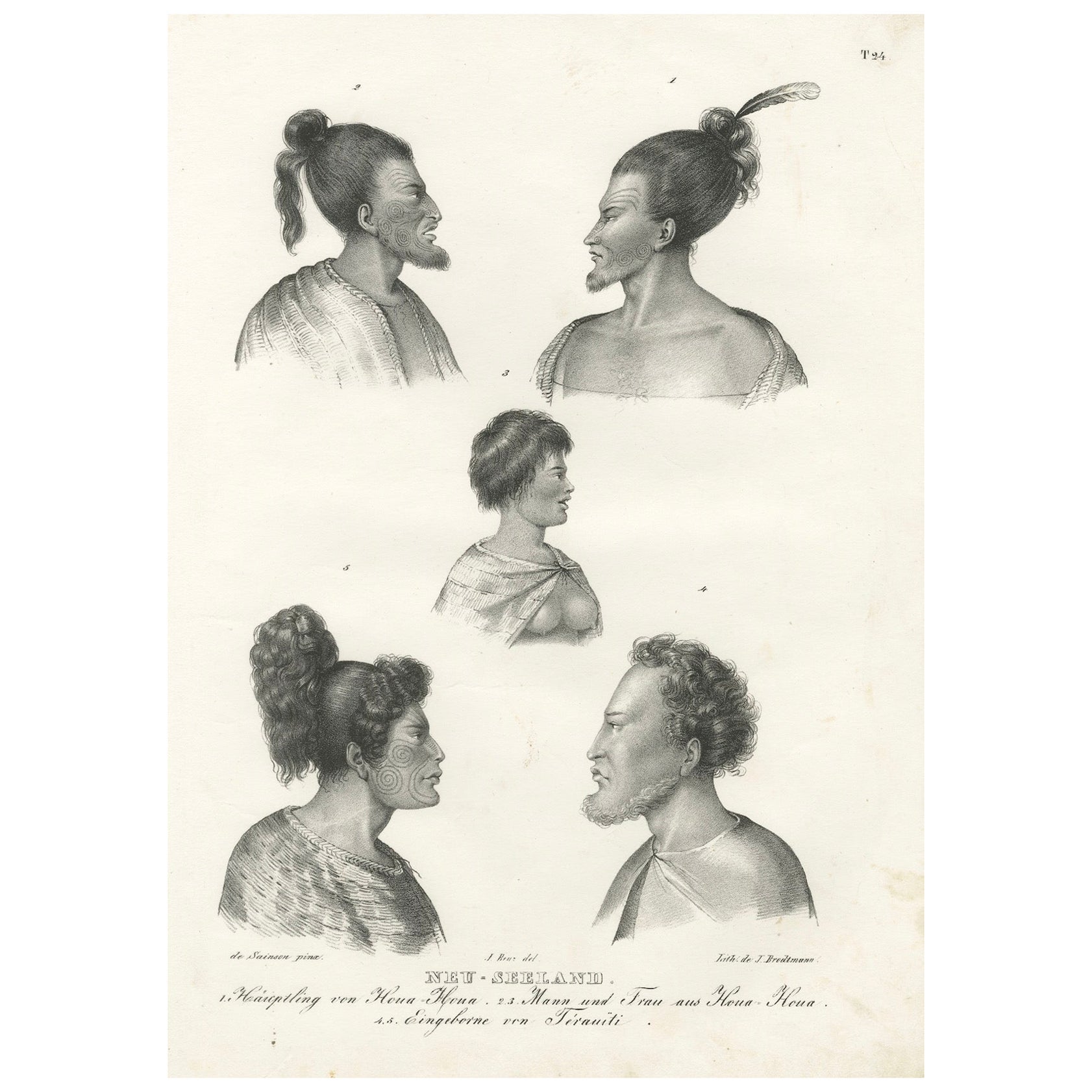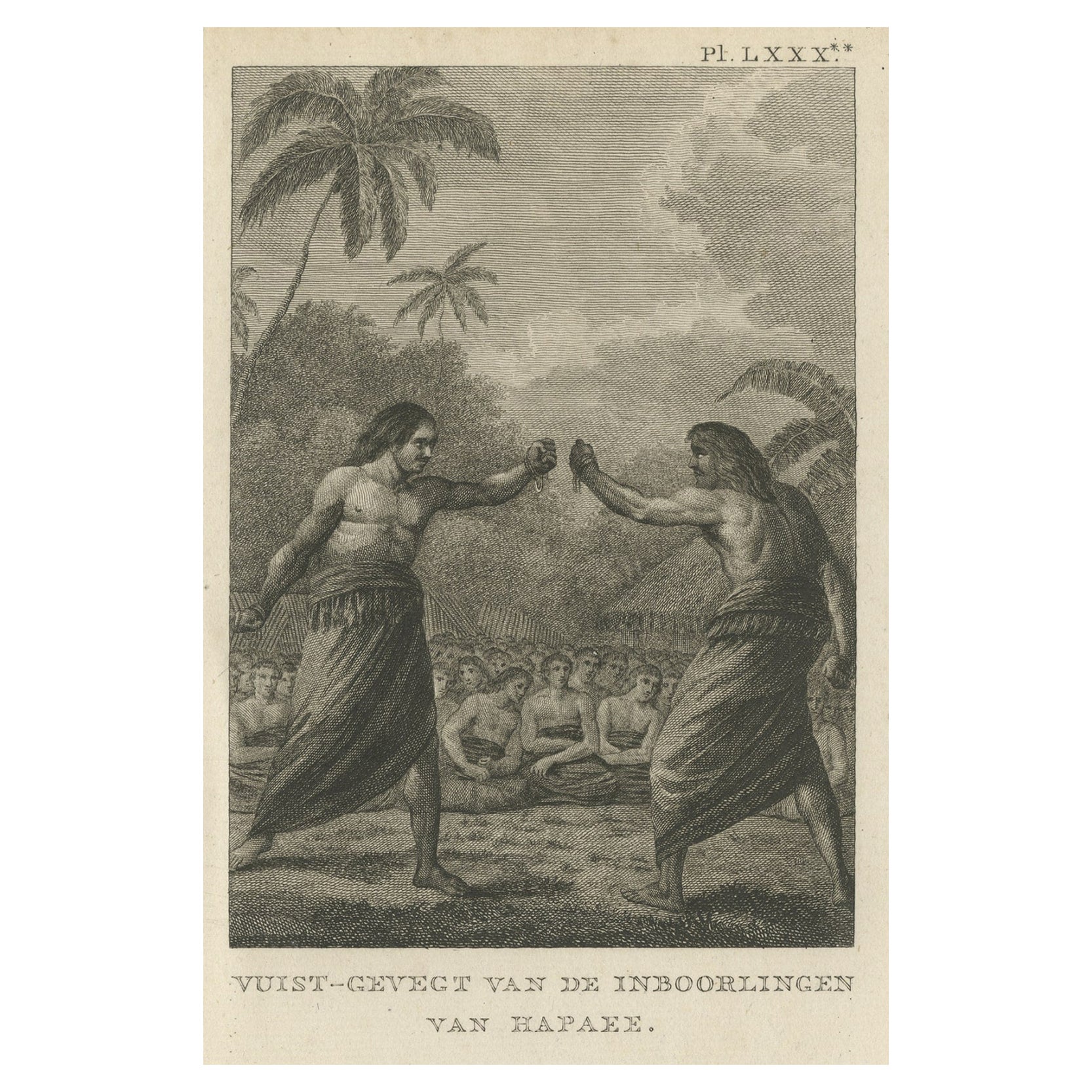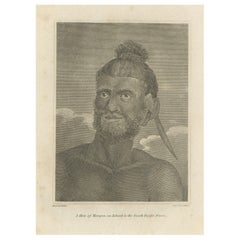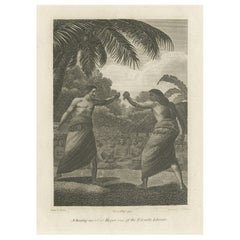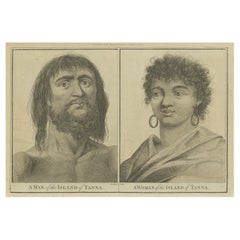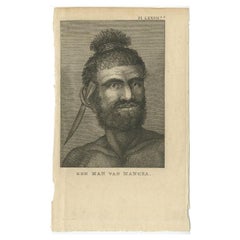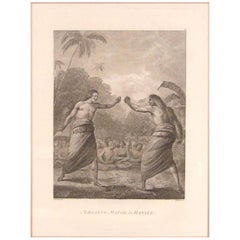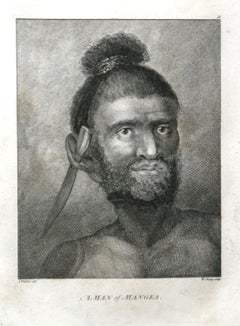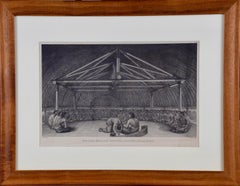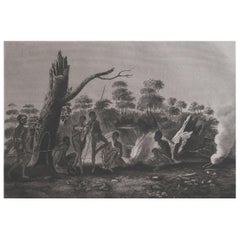Items Similar to Traditions and Faces of the Pacific: Boxing in Ha'apai and a Man of Mangea, 1785
Want more images or videos?
Request additional images or videos from the seller
1 of 10
Traditions and Faces of the Pacific: Boxing in Ha'apai and a Man of Mangea, 1785
$211.06
$263.8220% Off
£157
£196.2520% Off
€176
€22020% Off
CA$289.01
CA$361.2620% Off
A$321.34
A$401.6720% Off
CHF 167.78
CHF 209.7320% Off
MX$3,911.45
MX$4,889.3120% Off
NOK 2,140.85
NOK 2,676.0720% Off
SEK 2,005.88
SEK 2,507.3520% Off
DKK 1,339.79
DKK 1,674.7420% Off
Shipping
Retrieving quote...The 1stDibs Promise:
Authenticity Guarantee,
Money-Back Guarantee,
24-Hour Cancellation
About the Item
The engraving appears to be from the Captain James Cook's voyages, which took place between 1768 and 1779. Since it is related to Cook's expeditions and given the style of the engraving, it's likely that this piece was published in the late 18th century, possibly in the years following Cook's last voyage, which ended in 1779.
The mention of "A New, authentic and complete account of voyages around the world ..." suggests it might have been published as part of a comprehensive account of Cook's journeys. These accounts were often published shortly after the voyages themselves to satisfy public interest, so a reasonable estimate for the publication of this engraving would be in the 1780s.
**Ha'apai (Hapaee):**
Ha'apai is a group of islands that form part of the Kingdom of Tonga in the South Pacific. The islands are known for their rich cultural heritage, and they were one of the many places visited by Captain James Cook during his Pacific voyages. The engraving showing a boxing match is likely to be an illustration of a local sport or cultural practice observed by the crew of Cook's expedition. Traditional sports such as boxing were important social events in many Pacific cultures, often associated with festivals or ceremonial occasions.
**Mangaia (Mangea):**
Mangaia is the most southerly of the Cook Islands and the second largest, after Rarotonga. It is known for its rich history and is often referred to as an island with strong traditions and cultural practices. The Cook Islands themselves were named after Captain James Cook, although he only visited some of the islands that now bear his name. Mangaia has a deeply layered cultural history with a social structure that includes traditional leaders known as 'ariki and a warrior class. The detailed portrait of a man from Mangaia in the engraving would have been of significant interest to Europeans of the time, as it provided a visual record of the physical appearance and personal adornment of people from a culture so different from their own.
Both Ha'apai and Mangaia were important stops during the age of exploration in the Pacific, providing Europeans with new insights into the diversity of cultures, languages, and practices in this part of the world. The interactions between European explorers and the inhabitants of these islands would have been moments of cultural exchange, curiosity, and, at times, misunderstanding, but they significantly contributed to the broader knowledge of the Pacific peoples during this period.
- Dimensions:Height: 9.65 in (24.5 cm)Width: 14.97 in (38 cm)Depth: 0 in (0.02 mm)
- Materials and Techniques:Paper,Engraved
- Period:1780-1789
- Date of Manufacture:circa 1785
- Condition:Fair condition. The paper thin and showing some soiling and minor browning, mostly around the edges. Some edges rough with creases but mostly outsides the images. Study the images carefully.
- Seller Location:Langweer, NL
- Reference Number:Seller: BG-13597-1031stDibs: LU3054337982332
About the Seller
5.0
Recognized Seller
These prestigious sellers are industry leaders and represent the highest echelon for item quality and design.
Platinum Seller
Premium sellers with a 4.7+ rating and 24-hour response times
Established in 2009
1stDibs seller since 2017
2,510 sales on 1stDibs
Typical response time: <1 hour
- ShippingRetrieving quote...Shipping from: Langweer, Netherlands
- Return Policy
Authenticity Guarantee
In the unlikely event there’s an issue with an item’s authenticity, contact us within 1 year for a full refund. DetailsMoney-Back Guarantee
If your item is not as described, is damaged in transit, or does not arrive, contact us within 7 days for a full refund. Details24-Hour Cancellation
You have a 24-hour grace period in which to reconsider your purchase, with no questions asked.Vetted Professional Sellers
Our world-class sellers must adhere to strict standards for service and quality, maintaining the integrity of our listings.Price-Match Guarantee
If you find that a seller listed the same item for a lower price elsewhere, we’ll match it.Trusted Global Delivery
Our best-in-class carrier network provides specialized shipping options worldwide, including custom delivery.More From This Seller
View AllPortrait of a Mangean Islander in The South Pacific by John Webber, circa 1800
Located in Langweer, NL
A head and shoulders frontal portrait of a man named by Cook as Mourua, of Mangaia, Cook Islands, visited by Cook in March 1777.
Title: "Portrait of a Mangean Islander by John Webbe...
Category
Antique Early 1800s Prints
Materials
Paper
$134 Sale Price
20% Off
A Boxing Match, in Hapaee, One of the Hawaii Islands, circa 1780
Located in Langweer, NL
John Webber created the engraving titled "A Boxing Match, in Hapaee, one of the Friendly Islands." Webber was indeed an artist who accompanied Captain James Cook on his third voyage ...
Category
Antique Late 18th Century Prints
Materials
Paper
Diversity of Tanna: Portraits of a Man and Woman from Vanuatu’s Isle, ca.1785
Located in Langweer, NL
The engraving features two individual portraits side by side, labeled as inhabitants of the island of Tanna, which is part of Vanuatu in the South Pacific.
On the left is "A MAN of the Island of TANNA." He is depicted with a serious, almost stern expression, looking slightly to the side. His facial features are marked by a prominent beard and mustache, and his hair appears long and wavy. This detailed portrayal suggests an effort to capture the unique physical characteristics and possibly the demeanor of the man.
On the right is "A WOMAN of the Island of TANNA." She is shown in a three-quarter view with a gentle expression, looking directly at the viewer. Her hair is styled in tight curls, she wears large hoop earrings, and her clothing drapes softly over her shoulders, indicating a level of adornment and style.
The portraits likely aimed to depict the natural appearance and attire of the people from Tanna as accurately as possible for European audiences of the time. These works often sought to provide a detailed record of the diverse cultures encountered during exploration voyages.
The style of the engraving and the reference to Captain Cook's voyages suggest that it comes from the late 18th century, likely in the period following Cook's final voyage, which ended in 1779. The engravings of Pacific peoples associated with Cook's voyages were often published in the various accounts that proliferated after his travels, as there was a keen interest in the newly contacted peoples of the Pacific.
The text on the engraving says it was "Accurately Engraved for Anderson's Large Folio Edition of the Whole of Capt'n. Cook's Voyages &c. Complete." This indicates that the engraving was made for a specific publication by Anderson, compiling Captain Cook's voyages. George William Anderson is known for his compilation titled "A New, Authentic, and Complete Collection of Voyages Round the World," which was published initially in the 1780s. This collection often included large folio engravings such as this one.
Given this information, we can reasonably estimate that this engraving would have been published sometime in the 1780s. However, without specific publication data, it is not possible to provide an exact year. Such details would typically be found in a library catalog...
Category
Antique 1780s Prints
Materials
Paper
$211 Sale Price
20% Off
Antique Print of a Man of Mangaia by Cook, 1803
By Cook
Located in Langweer, NL
Antique print titled 'Een Man van Mangeea'. Antique print depicting a man of Mangaia, Cook Islands. Originates from 'Reizen Rondom de Waereld door James Cook (..)'.
Artists and E...
Category
Antique 19th Century Prints
Materials
Paper
$182 Sale Price
20% Off
Guardians of Heritage: Maori Chiefs and Families from Hiva Oa and Tewaaiti, 1836
Located in Langweer, NL
Title: Maori Chiefs and Families from Hiva Oa and Tewaaiti
Description: This lithograph, part of the early 19th-century collection documenting indigenous peoples of the Pacific, f...
Category
Antique 1830s Prints
Materials
Paper
Old Print of a Boxing Fight Between Two Natives of Hapaee, Tonga Islands, 1803
Located in Langweer, NL
Antique print titled 'Vuist-Gevegt van de Inboorlingen van Hapaee'.
Antique print depicting a fight between two natives of Hapaee. Originates from 'Reizen Rondom de Waereld door ...
Category
Antique Early 1800s Prints
Materials
Paper
$249 Sale Price
20% Off
You May Also Like
Copper Engraving "Boxing Match in Hapaee from Cook's Voyages" after John Webber
By John Webber
Located in San Francisco, CA
J. Webber: A boxing match in Hapaee (Hawaii). An original copper plate engraving on paper depicting a boxing match as witnessed during Cook's third voyage...
Category
Antique 18th Century English Decorative Art
Materials
Paper
A Man of Mangea 1784 final voyage of Captain Cook by John Webber
By John Webber
Located in Paonia, CO
A Man of Mangea is from the 1784 First Edition Atlas Accompanying Capt. James Cook and King; Third and Final Voyage of Captain James Cook. John Webber (1752-1793) was the official a...
Category
1780s Realist Portrait Prints
Materials
Engraving
"King of the Friendly Islands" (Tonga); Engraving from Captain Cook's 3rd Voyage
By John Webber
Located in Alamo, CA
"Poulaho, King of the Friendly Islands, Drinking Kava" is an engraving created by William Sharp (1749-1824), from a drawing by John Webber (1752-1793), who was the artist on Captain James Cook's 3rd and final voyage of discovery. It was published in the atlas of "A Voyage to the Pacific Ocean Undertaken by the Command of His Majesty, for Making Discoveries in the Northern Hemisphere", the official British Admirality sanctioned journal published upon completion of the voyage in London in 1784 by Strahan & Cadell.
Captain Cook visited Tonga on his 3rd voyage, which he named The Friendly Islands because of the warm welcome he and his crew received, unlike some of the other more hostile Pacific islands. The engraving depicts Cook and his men observed a kava ceremony at the village of Mu’a on Tongatapu. King Paulaho sits in the centre foreground, his back to the spectator with a man kneeling before him. The ceremonial mat depicted behind Paulaho indicates that nobody was allowed to sit behind him. The figure in the centre holds a single cup, referring to the Tongan custom of offering the cup to the king first. Kava is native to the islands of the South Pacific and was first described for English readers in 1768 by Captain James Cook. The kava root has been used for centuries as a central feature of ceremonies and celebrations because it was able to bring about a calming and pleasant social atmosphere. The root was crushed and processed into coconut milk to become the focal ceremonial beverage, simply referred to as kava.
This engraving is presented in a Koa wood frame and a white mat. Koa wood is legendary in Hawaii. There are occasional faint spots, but the print is otherwise in very good condition. This amazing Koa wood is native to Hawaii and it is known for the deep rich colors and varied grain pattern. Koa has an honored heritage in Hawaii and is highly revered and sacred. The word “koa” means “warrior” in Hawaiian. The warriors of King Kamehameha the Great, created canoes and weapons from a wood plentiful on the Big Island of Hawaii. This wood became synonymous with the warriors themselves, and it became known as koa.
There are three other engravings listed from the official journal of Captain Cook's 3rd voyage available that are presented in identical Koa wood frames and mats (LU117324682422, LU117324684052, LU117324684032). They would make a wonderful grouping for a display of 2, 3 or 4 prints. A discount is available for a grouping depending on the number of items included.
Captain Cook is remembered as one of the greatest explorers and navigators in history. His explorations included Australia, New Zealand and islands of the South Pacific and the northwest coast of North America. Hawaii was discovered by Captain Cook during this voyage. Hawaii was originally called The Sandwich Islands in honor of The Earl of Sandwich...
Category
1780s Realist Figurative Prints
Materials
Engraving
Original Antique Ethnographical Print, Figures, New South Wales, Australia, 1809
Located in St Annes, Lancashire
Wonderful ethnographical print.
A copper-plate engraving after Lesieur
Published by Sherwood, Neely & Jones. Dated 1809
Unframed.
Category
Antique Early 1800s English Folk Art Prints
Materials
Paper
Guerrier de Tonga Tabou - Lithograph by Auguste Wahlen - 1844
Located in Roma, IT
Guerrier de Tonga Tabou is a hand colored lithograph realized by Auguste Wahlen in 1844.
Good condition.
The artwork belongs to the Suite Moeurs, usages et costumes de tous les peu...
Category
1840s Modern Figurative Prints
Materials
Lithograph
Indigenous Costumes - Original Lithograph - 19th Century
Located in Roma, IT
Indigenous Costumes is an original lithograph realized by an anonymous engraver of the 19th Century.
Printed as part of the series "France Pittoresque", as indicated at the top cent...
Category
19th Century Figurative Prints
Materials
Lithograph
